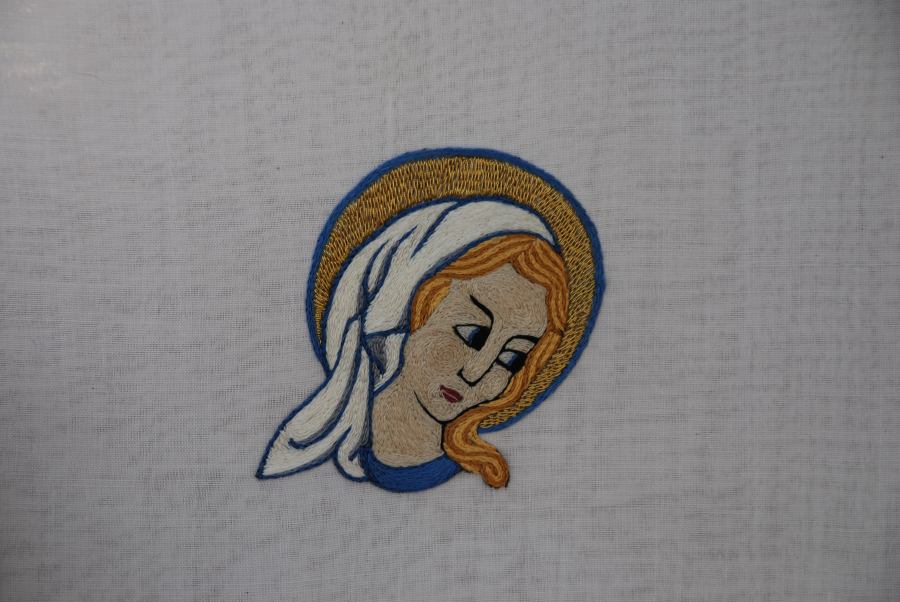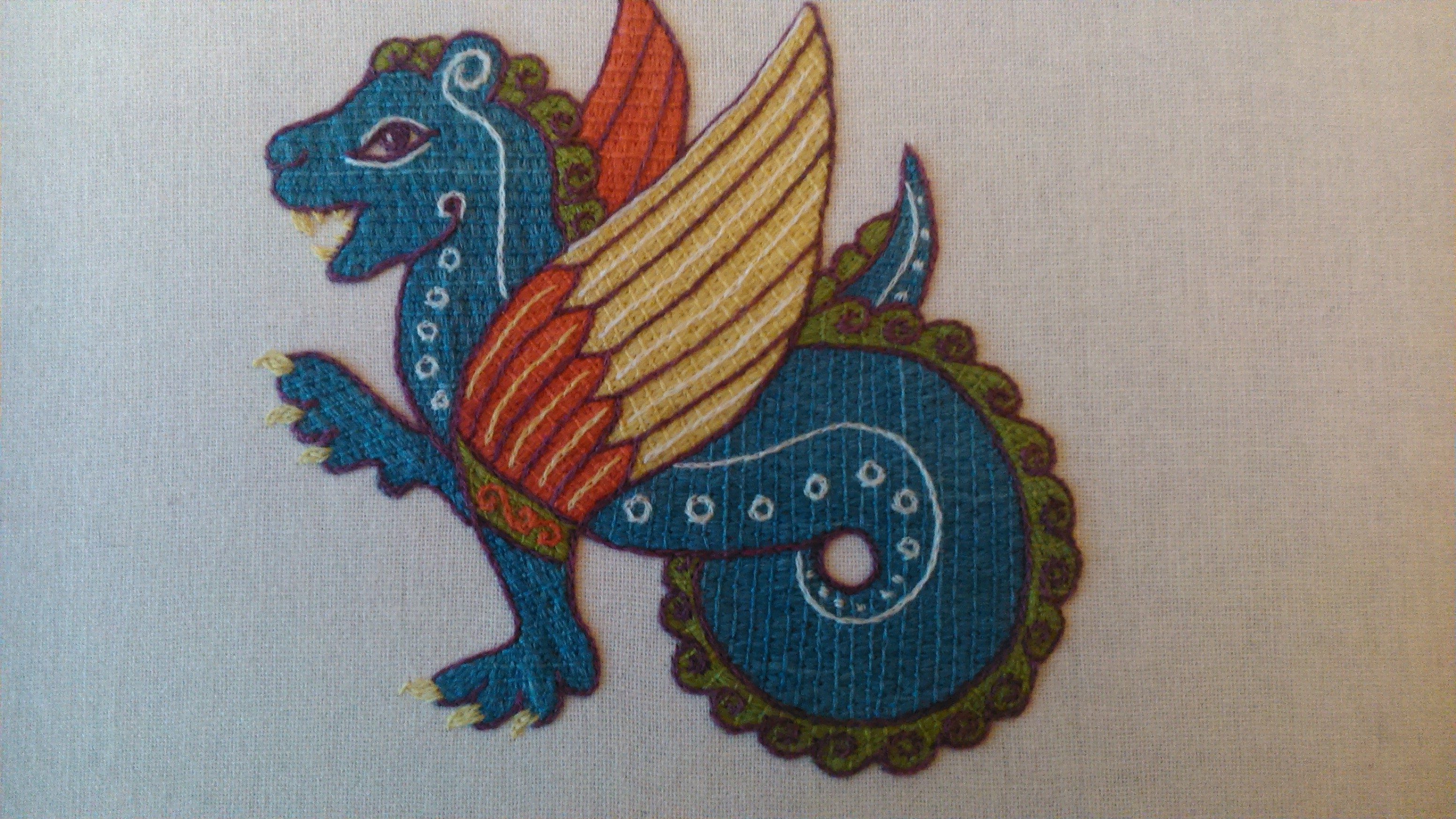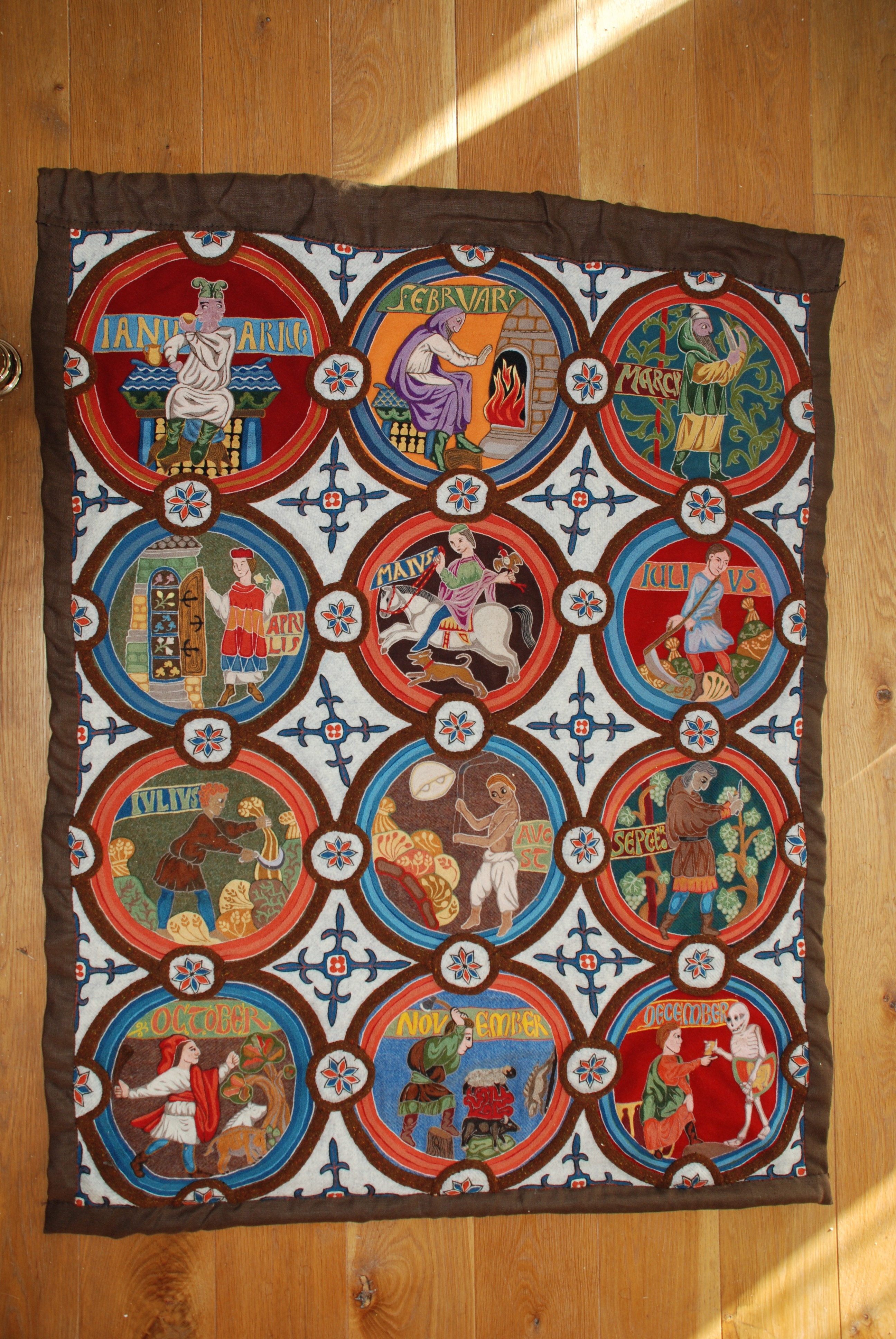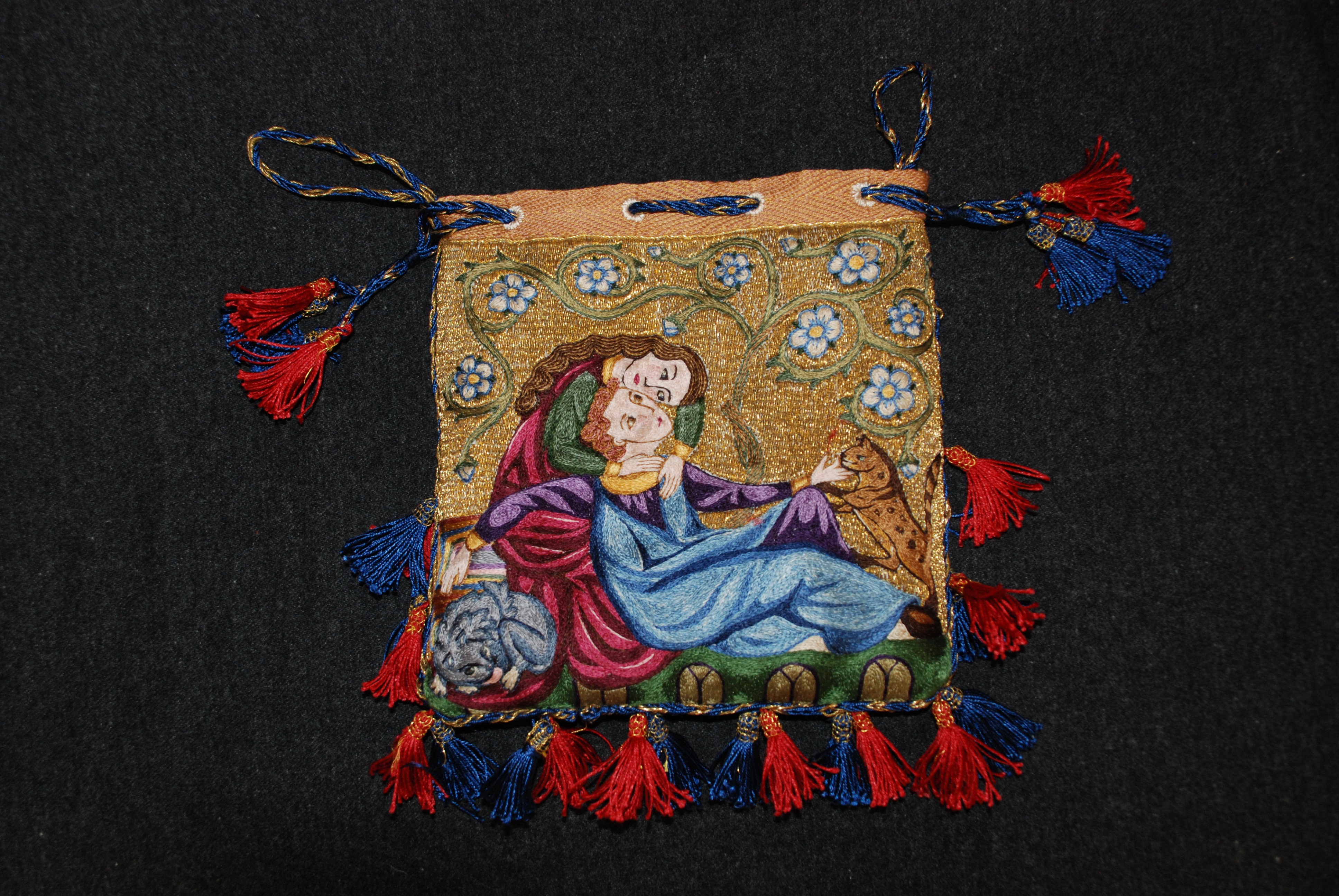Reykjahlid antependium update
So, I’ve been working on the Antependium, or at least I have on the rare evenings I’ve sent at home.
I’ve tried to match my veg dyed colours to the original as far as possible – madder red is fairly easy to discern, as are yellows, but that very very dark colour in the original could be black or blue. I dyed both a dark blue and a compound almost black (it would have been black, I swear it would, if my indigo bath had held out for a few more dips, but alas it was not to be), and have been using both, basically as and where I find them to fit the design best, which is all I can do given the limited information at my disposal.
I am quite happy with the way the colours are working together though.
I was a bit unsure about the colours at this stage, but…
 Once I put the outline stitch was in place it really pulled the whole thing together.
Once I put the outline stitch was in place it really pulled the whole thing together.
I had started out by using the same thread for couching the laid work, but found it too thick. I am aware that the originals often used a thinner thread for the couching, but when I was doing the dyeing I hadn’t had any thinner to hand, and since I was loathe to used a commercially dyed thread against my own natural dyeing, I ended up by unplying some of the thread to do the couching with. This worked surprisingly well – it didn’t break as one might have expected it too, and the thinner thread flowed better through the laid work, snagging far less.
 If you look closely here you might be able to see that the red is couched with the thick thread, whereas the yellow and blue are couched with thinner, and thus look far closer in effect to the original.
If you look closely here you might be able to see that the red is couched with the thick thread, whereas the yellow and blue are couched with thinner, and thus look far closer in effect to the original.
 The thing that really surprised me was the couching thread used as outline. My previous experience of laid and couched work has been in the style of Bayeux, which uses split and stem stitch as an outline, but if you look closely at the Icelandic pieces you can clearly see that many of the outlines are couched (often it’s really obvious where the couched and couching threads have faded to different colours). My lazy brain had looked at this and thought, “gosh, that looks nice and quick to do!” But it turns out that couching an outline can be quite faffy and slow – or maybe I just need to get my hand in and by the time I finish I’ll get faster, who knows?
The thing that really surprised me was the couching thread used as outline. My previous experience of laid and couched work has been in the style of Bayeux, which uses split and stem stitch as an outline, but if you look closely at the Icelandic pieces you can clearly see that many of the outlines are couched (often it’s really obvious where the couched and couching threads have faded to different colours). My lazy brain had looked at this and thought, “gosh, that looks nice and quick to do!” But it turns out that couching an outline can be quite faffy and slow – or maybe I just need to get my hand in and by the time I finish I’ll get faster, who knows?
I’m about to roll the frame on, but before I do I will tack some scrap fabric over the embroidered area to protect it. Not, as you might think, from rubbing on the back of itself, but from rubbing on me. My main embroidery time is in the evening after dinner, I’m a messy eater and like to work by leaning the frame against my ribs – I don’t want any bolognese etc that might have accidentally found its way onto my shirt getting ingrained into the embroidery. I’ve done this before and it works very well, especially on big pieces like this where there are long gaps between rolling it on.
Am now quite excited about doing the first of the roundels (which will really be number seven in the story arc), as I’ll get to play with more new colours (green!) but first there will be a bit more border and some of the spandrels



















Look very lovely
Wonderful job
I am quite enjoying the play of colours on this project, thanks
I am a natural dyer in Colorado USA. I have been struggling with getting that lovely madder red shade for almost a year now. Would you be willing to share how you got it? The embroidery is lovely! What weight thread do you use? We are looking for a source for great embroidery thread to naturally dye. I’d love a suggestion if you are willing to share! Thanks! Leonora Outlands
erm, I don’t do as much dyeing as you probably do, to be honest. I’m in a soft water area so I added a little chalk to my dyebath, the thread was premordanted with alum, then dyed.
the thread used was one sold for weavers, and it was bleached, which I noticed increased the intensity of all my colours that I dyed for this. It came from fibrecrafts/george wiel, altho I can’t quite remember what it was, butit was part of thier standard range and they have a net catalogue
also, the madder was best turkish – the expensive stuff – which I’d had in a dark cupboard fr three years or so. Now I;ve read that the best turkey reds were always achieved from matured madder, and I had wondered if that had contributed to the intense colour?
The colours look just lovely! Great work!!
I amquite pleased with how well they are all sitting together
I’d be pleased if the colours came together for an Elizabethan piece when selecting from the DMC range.
You DYED your’s! I would be rapt, myself *grin* (rapt = really happy) 🙂
sweetie, I do know what rapt means, and no I dont mean wrapped like sweeties
mmmm, sweeties…. drool…
what are you making? I’ve always preffered appletons to dmc, but thats cos I like crewel wools over tapestry, but appletons can be a right sod to get hold of.
Its good that these are working so well, cos when you dye them yourself you sort of get what you’re given and there isn;t much choice involved. but i think most naturally dyed colours work well together(apart from kermes pink, the beauty of which is that is clashes gloriously wiht everything)
Oh, like I can keep up with which nationality uses which slang! *grin* I can’t actually remember which country you are in! With the wonderful Net, it doesn’t make much difference, either 🙂
I’ve not used wool, except in a kit of a Tree of Life I did in my twenties – gods only know what that was. I’m looking forward to getting Rennassance Dye’s Elizabethan Range for some Jacobean work when I get up to that.
Currently, I’m working on a 3 D sunflower for a mentally ill friend. (A ball made of dupion, with a sunflower centre covering one end, done in Turkey stitch and various green/mustard colours – ugh, but he likes them. I’ve yet to put a couple of layers of ribbon loops just under the centre to represent petals.
And of course my Butterfly for my friend Juels. I have more work to do on the body and head.
Then a goldwork/silk project (The Bishop’s Cope) – I’m REALLY looking forward to doing it! I’ve got the silk now – a mixture of Pearsall’s filoselle, and Au Ver Soie D’Alger (ok, I nicked it out of the Masterclass kits, coz some of the Pearsall’s colous weren’t quite right and they were perfect).
But my health sux bigtime (and has for over a month now, I’m sodding bedridden 95% of the time…BOOOORINNNGG) so I haven’t gotten to embroider at all! I’m in withdrawal! Hopefully I’ll be back at it in a few weeks.
Wonderful job.
Prompt, please. You used what stitches in work?
the main body of it is a stitch called laid and couched work, which is used for the bayeux tapestry, with details in split stitch adn more couching
Wow! You do such beautiful work. Are you keeping track of how many hours this is taking? Any guess as to how many ladies worked on the Bayeux tapestry?
it must have been a whole workshop full for the bayeaux (I went to a very intersting set of lecture on that piece yesterday at the IMC)
I never keep track of how many hours, different people sew at different speeds so I;ve never understood the obsession. I sew most evenings after dinner, until I get tired or bored
LOVELY
thanks
That is just awswome! Where did you find the pattern for the boarder from? Well the pattern for the whole thing really. Its a cool project!
its a replica of an original antependium from iceland, the whole thing is based on it
Your work just makes me drool …its cool! I would love to do something like this to hang on the wall.
give it a go – the technique itself isn’t difficult, its simply the scale of mine thats a little large